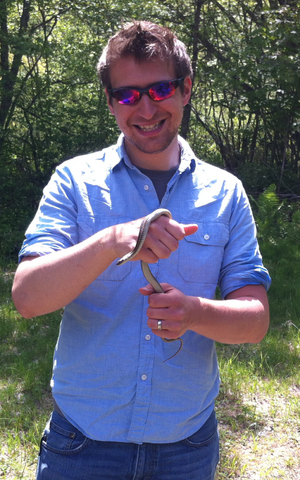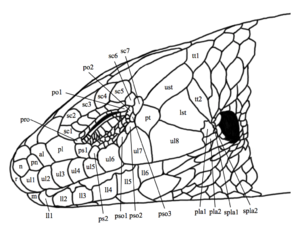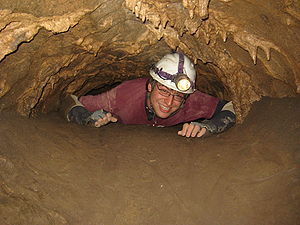Difference between revisions of "Andrew Frank"
Andrew Frank (Talk | contribs) |
Andrew Frank (Talk | contribs) |
||
| Line 29: | Line 29: | ||
==Research== | ==Research== | ||
| − | === | + | ===Current Interests=== |
I am interested in answering evolutionary questions by leveraging molecular data in novel ways. My current graduate work focuses on three core interests: speciation and population genetics, systematics and taxonomy, and deep-level phylogenetics. Broadly speaking, I am interested in... | I am interested in answering evolutionary questions by leveraging molecular data in novel ways. My current graduate work focuses on three core interests: speciation and population genetics, systematics and taxonomy, and deep-level phylogenetics. Broadly speaking, I am interested in... | ||
| − | * [http://today.uconn.edu/blog/2014/04/three-graduate-students-awarded-nsf-research-fellowships/ The development of | + | * [http://today.uconn.edu/blog/2014/04/three-graduate-students-awarded-nsf-research-fellowships/ The development of coalescent methods to detect parallel speciation in North American ''Plestiodon'' skinks] |
| − | * [http://www.american.edu/cas/news/Gammarus-Minus-Capstones.cfm Phenotypic changes in relation to processes of speciation, | + | * [http://www.american.edu/cas/news/Gammarus-Minus-Capstones.cfm Phenotypic changes in relation to processes of speciation, e.g. those associated with a transition to a cave-dwelling phenotype] |
* Testing support for root placements in the squamate molecular data set of Wiens et al. 2012 to resolve differences between morphological and molecular phylogenies of Squamata | * Testing support for root placements in the squamate molecular data set of Wiens et al. 2012 to resolve differences between morphological and molecular phylogenies of Squamata | ||
===Programming=== | ===Programming=== | ||
| − | * [https://github.com/andrewfrank/Decatenater Decatenater] - | + | * [https://github.com/andrewfrank/Decatenater Decatenater] - An R pipeline that accepts a nexus format concatenated nucleotide alignment as input, and outputs a number of useful files for each gene alignment that makes up the input concatenated alignment. These files include nexus and phylip alignments for the individual genes, a nexus file containing a PAUP block that executes PAUP's basefreqs function per gene per codon position, and PartitionFinder configuration files for each gene. Decatenater also allows the user to exclude multiple sets of taxa from the input concatenated nexus file and outputs files that lack indicated taxa. Additional pipeline steps for Decatenater are currently in development, including automation of PartitionFinder, garli, RAxML, and BEAST analyses. |
==Awards== | ==Awards== | ||
| Line 48: | Line 48: | ||
==About Me== | ==About Me== | ||
| − | My initial interest in biology took root in the incredible complexity of the very small. As an undergraduate at American University, I explored changes in morphology in the freshwater amphipod ''Gammarus minus'' as it invaded cave environments in West Virginia. Caving in the valleys of West Virginia, doing faunal surveys, and collecting amphipods created a passion and sense of discovery | + | My initial interest in biology took root in the incredible complexity of the very small. As an undergraduate at American University, I explored changes in morphology in the freshwater amphipod ''Gammarus minus'' as it invaded cave environments in West Virginia. Caving in the valleys of West Virginia, doing faunal surveys, and collecting amphipods created a passion and sense of discovery in biological work. |
| − | My amphipod research experience helped me continue my scientific work as an undergraduate at the Smithsonian National Museum of Natural History. There, I worked with Dr. Jon Norenburg | + | My amphipod research experience helped me continue my scientific work as an undergraduate at the Smithsonian National Museum of Natural History. There, I worked with Dr. Jon Norenburg to differentiate two species of marine Nemertean worms, ''Lineus ruber'' and ''Lineus viridus'', using the molecular barcode gene, COI. Working at the Smithsonian created a burgeoning attraction to molecular systematics, and strongly influenced my desire to pursue graduate work in this field. |
In my senior year at American, I applied and was accepted to Teach for America. For the next two years of my life, I became dedicated to the scientific education of 240 high school freshman. I taught a freshman level science and engineering course at the Academy of Engineering and Green Technology (AoEGT) in Hartford, CT. At AoEGT, I became invested in producing a hands-on curriculum that drove curiosity and captured interest, and started creating projects using under-used resources in the school. | In my senior year at American, I applied and was accepted to Teach for America. For the next two years of my life, I became dedicated to the scientific education of 240 high school freshman. I taught a freshman level science and engineering course at the Academy of Engineering and Green Technology (AoEGT) in Hartford, CT. At AoEGT, I became invested in producing a hands-on curriculum that drove curiosity and captured interest, and started creating projects using under-used resources in the school. | ||
Revision as of 15:27, 30 October 2014
Contents
Contact Information
Email: andrew.frank@uconn.edu
Phone: (845) 728-6551
Office: BPB 322
Mailing Address: Department of Ecology and Evolutionary Biology
University of Connecticut
75 N. Eagleville Road Unit 3043
Storrs, CT 06269
Education
PhD Student, University of Connecticut, Ecology and Evolutionary Biology 2013-present
Major Advisor: Elizabeth Jockusch, Ph.D.
Bachelor of Science, American University, Department of Biology 2007-2011
Thesis Advisor: David Carlini, Ph.D.
Research
Current Interests
I am interested in answering evolutionary questions by leveraging molecular data in novel ways. My current graduate work focuses on three core interests: speciation and population genetics, systematics and taxonomy, and deep-level phylogenetics. Broadly speaking, I am interested in...
- The development of coalescent methods to detect parallel speciation in North American Plestiodon skinks
- Phenotypic changes in relation to processes of speciation, e.g. those associated with a transition to a cave-dwelling phenotype
- Testing support for root placements in the squamate molecular data set of Wiens et al. 2012 to resolve differences between morphological and molecular phylogenies of Squamata
Programming
- Decatenater - An R pipeline that accepts a nexus format concatenated nucleotide alignment as input, and outputs a number of useful files for each gene alignment that makes up the input concatenated alignment. These files include nexus and phylip alignments for the individual genes, a nexus file containing a PAUP block that executes PAUP's basefreqs function per gene per codon position, and PartitionFinder configuration files for each gene. Decatenater also allows the user to exclude multiple sets of taxa from the input concatenated nexus file and outputs files that lack indicated taxa. Additional pipeline steps for Decatenater are currently in development, including automation of PartitionFinder, garli, RAxML, and BEAST analyses.
Awards
- 2014: SSAR Grants in Herpetology, Laboratory category - $500
- 2014: Society for the Study of Evolution Rosemary Grant Award - $2461
- 2014: University of Connecticut Department of Ecology and Evolutionary Biology and CT Museum of Natural History, Ralph M. Wetzel Vertebrate Research Award - $400
- 2014: National Science Foundation Graduate Research Fellow
- 2011: University Honors in Biology, magna cum laude
- 2010: Best natural science poster by a junior/senior, American University Mathias Student Research Conference
- 2008: Stephen J. Grebe Award for undergraduate summer research
About Me
My initial interest in biology took root in the incredible complexity of the very small. As an undergraduate at American University, I explored changes in morphology in the freshwater amphipod Gammarus minus as it invaded cave environments in West Virginia. Caving in the valleys of West Virginia, doing faunal surveys, and collecting amphipods created a passion and sense of discovery in biological work.
My amphipod research experience helped me continue my scientific work as an undergraduate at the Smithsonian National Museum of Natural History. There, I worked with Dr. Jon Norenburg to differentiate two species of marine Nemertean worms, Lineus ruber and Lineus viridus, using the molecular barcode gene, COI. Working at the Smithsonian created a burgeoning attraction to molecular systematics, and strongly influenced my desire to pursue graduate work in this field.
In my senior year at American, I applied and was accepted to Teach for America. For the next two years of my life, I became dedicated to the scientific education of 240 high school freshman. I taught a freshman level science and engineering course at the Academy of Engineering and Green Technology (AoEGT) in Hartford, CT. At AoEGT, I became invested in producing a hands-on curriculum that drove curiosity and captured interest, and started creating projects using under-used resources in the school.
After my two-year commitment to Teach for America, I enrolled as a graduate student at the University of Connecticut, where I am currently pursuing research on parallel speciation and the molecular systematics of lizards.
Presentations
Frank, A., and Carlini, D. Isolating Microsatellite Sequences for Development of Microsatellite Primers for Cave and Surface Amphipod Gammarus minus. Oral presentation. American University Mathias Student Research Conference. Washington, DC. May, 2011 PDF
Frank, A., and Norenburg, J. Species delimitation of two nemertean worms: effective application of DNA barcoding. Poster presentation. American University Mathias Student Research Conference. Washington, DC. May, 2010 PDF
Teaching
Fall 2013 - Spring 2014: Teaching Assistant, Foundations of Biology - University of Connecticut
Fall 2011 - Spring 2013: Secondary Science Teacher - Hartford Public High School, Hartford, CT
- Taught the two years, as a Teach for America corps member, of a pilot freshman level science and technology course in the economically deprived Hartford Public Schools.
- Designed and instituted a summer bridge program for middle school students transitioning into high school, resulting in a 15% improvement in participating student scores in freshman level science and technology.


